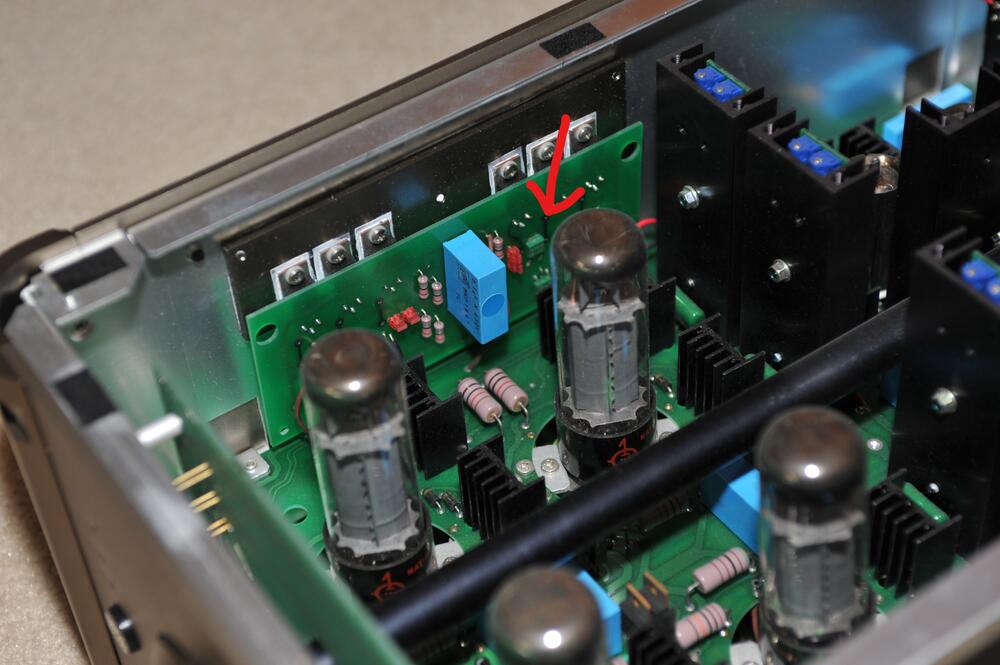-
Posts
1,527 -
Joined
-
Last visited
-
Days Won
16
Content Type
Profiles
Forums
Events
Everything posted by JoaMat
-
Nice progress, starcat. Some builders put LEDs on the other (tube) side... Also, putting battery 22K resistors on the tube side elevated half an inch makes it perfect for using clip leads when setting the voltage to 6.55V.
-
Great! Looking at your measurements of ref102 I suspect you might have the problem there. You should have a potential at Out (pin 6) of 10 volts above -562V - that will be -552V and not -532V. You have a spare ref102?
-
May I suggest a diode test comparison Q20 against Q15 to exclude the 2SC3675? If not already done.
-
Familiar with the diode test method? See this post. Seems the regulator isn’t doing anything but passing all unregulated voltage through. My bet is on a faulty mosfet... or something else.
-
Happy Birthday, Kerry!
-
Isn’t 2SA1413 a smd TO-252 something? Looking at picture below it seems Stax used something like that in the output current sources in SRM-T2. You might consider KSA1156 for 2SA1486 on heat sink and in batteries. Reduce high voltages to +/-400V and you can use KSA1156 in the output current sources as well. As I see it reducing the voltage is beneficial without drawbacks. I’ve used STN9360 in batteries and even in output current sources. Bend outer pads slightly outwards to fit holes and solder them in standing. In current sources they will idle at 1/4W.
-
One thing that differs is that Qobus for some albums have a link to PDF album booklet, which I like. Else I haven’t thought much of differences between them.
-
Here is the simple adapter I made. Black wire connected to left and middle pins of the green holder and red wire to right pin. Black banana to E on the meter and red to C. At some point I must have changed C and E connectors on the meter to bananas but I can’t remember having done that… P.S. Found this in cyber space: https://jestineyong.com/duoyi-dy294-meter-repair/ https://www.pa4tim.nl/?p=6022
-
Looks very nasty... really nasty.
-
That’s similar to what I do. But I have left and middle pins connected to one wire going to E on the meter while the third pin goes to C. When I measure j79/k216 I just put the transistor into the socket (be aware of orientation). For c3675 and a1486 I put their C and E pins into socket accordingly. When measuring breakdown voltages C and E are involved. If you want to measure Collector Emitter breakdown voltage than Collector to C and Emitter to E while Base is floating. In case you are measuring a Mosfet you should connect Drain to C and Source and Gate to E. Duoyi DY294 Operating Instructions.pdf
-
Aren’t there other similar .1uF/50V in stock at Mouser? For instance 80-C320C104J5R7301, but there are cheaper.
-
I’m out of town for a couple of days, but I see if I can post a picture of it when back home. Basically it just a piece of pcb, some three pin socket (green I think) and two wires.
-
Nice post with YouTube video clips above, James. One tool I’ve found very useful is desoldering gun. I use DEN-ON SC7000Z. The first one I bought nine years ago and it still working. Last year I bought a second one. DEN-ON isn’t cheap but it’s very reliable and it’s said to be possible to get spare parts if needed. There are different tips available and with the 1.5 mm I’ve desoldered the small 9 pin Teflon tube holder with ease. Another good thing with the DEN-ON is hot air blowing. With hot air blowing I remove smd parts. A few days ago when doing 0402 parts soldering exercise I tested to remove a few 0402 parts and that worked great. Then I put the parts back – good exercise...
-
Done some soldering exercise today. This small board contains 100 x 0402 10K resistors. Hand soldered with a Weller station, XNT-H tip and 0.3 mm solder wire. A few of the resistors are not flat to the board but I think they are acceptable soldered. Looking at your board, Kerry, there seems to be some really nasty things. Any chance for part numbers? I have to convince myself that the best way is to pay for a prepopulated board…
- 129 replies
-
- 10
-

-

-

-

-
Several years ago I changed all LEDs (only three per channel compared to 25 in the original DIY T2) in my modified T2 to LM336 2.5V, a voltage reference device in TO-92 case (I also changed resistor values to keep desired current of the CCS). Pros LED/BJT see Lefferts_LED_Used_as_Voltage_Reference_ED_Feb_15_1975.pdf. Pros LM336/BLT see Sources_101_P1.pdf and Sources_101_P2.pdf. Overall, at least in theory, I think LM336/BJT wins. My version of LM336 have operational temperature up to +70 degrees Celsius and I don’t think I exceed that.
-
Opened up my modified T2 from 2014, same circuit as James’ T2 but smaller board. All 140k resistors look as new. No decoloration at all but they are standing to save space. Maybe they are better cooled but it’s very crowded so I’m not sure about the cooling effect. A year ago I reduced the high voltages by 100V so batteries at 640V but before that it was “full” voltages. With three 140k resistors you get 1.7mA through lt1021-10 and I guess you can lower that to 1.2 – 1.3mA. 200k resistors gives 1.2mA and 300mW. Going with lt1021-7 as Kerry does you can reduce current further.
-
Great to hear about the new measurements which are in line with genuine 2SK216. When testing field effect transistors DY294 manual says “A short circuit should be formed between G and S pin. Otherwise the transistor can easily be damaged.” To make testing of k216/j79 a bit easier I’ve made a simple adapter for the DY294 tester.
-
Breakdown voltages that high for 2SK216 seem extraordinary. If the DY294 readings are correct I would say that the devices probably not are 2SK216.
-
A less contagious and unknown mutation? No need to. Informative posts are always appreciated.
-
Happy Birhtday, Kevin!
-
Great, this is the first time I see them boards, even if it’s just on photo. I want to add that one name is missing on the boards – Kevin Gilmore. Kevin added a few things like trimmers to set output current, test points to measure it, terminal blocks, part values, labels etc. etc.. During the work with the boards he taught me how to quickly make a mirrored (as far as possible) board from the first one. Thank you, Kevin. Welcome to Head-Case, Rich (sweetleaf)!
-
Thanks a lot for this project, Kevin and Kerry. At least the amp sections seem doable , even with my old eyes and clumsy hands. Is the board two layers or worse?
-
Many thanks Todd!
-
yep





